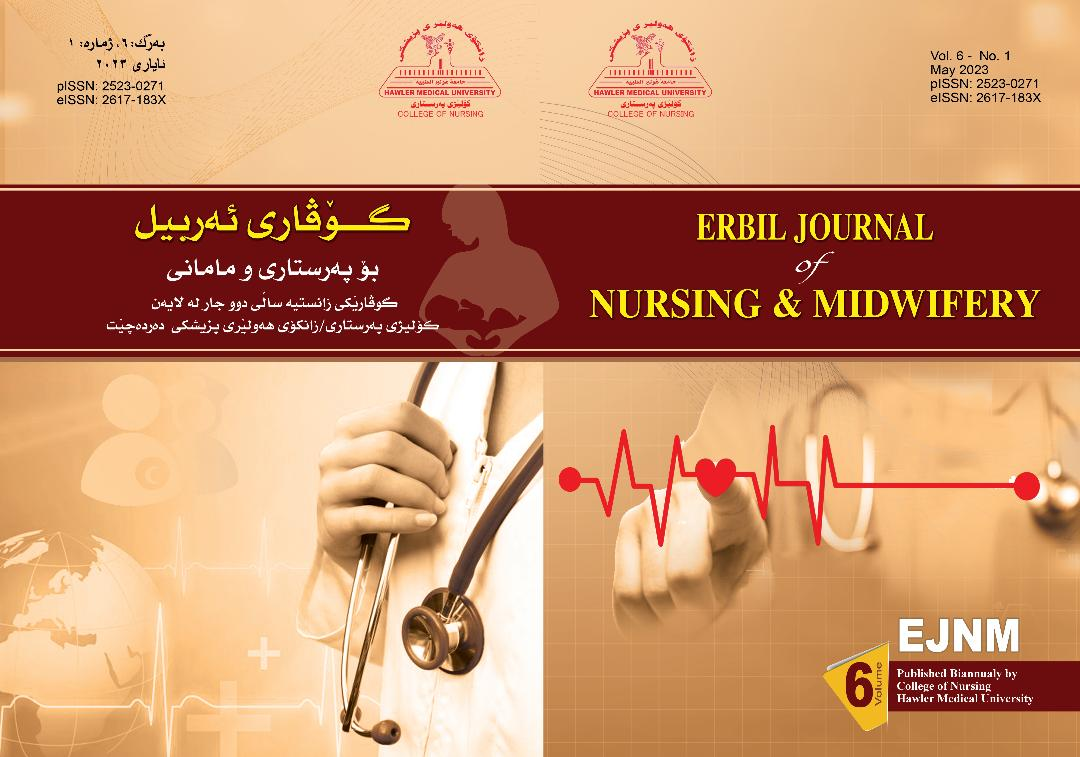Prevalence and Associated Factors with Attending Antenatal Care in Akre City, Iraq
DOI:
https://doi.org/10.15218/ejnm.2023.10Keywords:
Antenatal care, Prevalence, Factors, IraqAbstract
Background and Objectives: Antenatal care is essential for protecting the health of women and their unborn children. Antenatal care utilization is a key intervention in problem detection and treatment, promoting health-seeking behavior, and preparing pregnant women for birth. The present study aimed to investigate the prevalence and associated factors that affect attending and utilizing antenatal care in primary health care centers among pregnant women in Akre city.
Methods: A cross-sectional study was conducted in the Maternity Hospital of Akre City from November 21 to February 21, 2022. Data were collected through interviews with 400 women who attended the hospital for delivery and via a questionnaire constructed for the study. The questionnaire included women's socio-demographic characteristics, socio-economic status, obstetrical and reproductive history, and factors affecting antenatal care. Frequency, percentage, and chi-square tests were used to analyze the data.
Result: The rate of attending antennal care was 20%. The study findings showed a statistically significant association between attending antenatal care in the last pregnancy with residency, type of family, parity, and previous mode of delivery.
Conclusion: The prevalence of women who attend antenatal care is few. Effective media and providing special health care in primary health care centers and services are required to improve the level of awareness of pregnant women for utilizing antenatal care.
Metrics
References
Organization WH. WHO antenatal care recommendations for a positive pregnancy experience: nutritional interventions update: vitamin D supplements during pregnancy. 2020.
Konje ET, Magoma MT, Hatfield J, Kuhn S, Sauve RS, Dewey DM. Missed opportunities in antenatal care for improving the health of pregnant women and newborns in Geita district, Northwest Tanzania. BMC pregnancy and child-birth. 2018 Dec;18(1):1-13. Available from: https://doi.org/10.1186/s12884-018-2014-8 [Accessed: 20th Aug 2022].
World Health Organization. WHO recommends interventions for improving maternal and newborn health: integrated management of pregnancy and childbirth. World Health Organization; 2007.
Tunçalp Ӧzge, Pena-Rosas JP, Lawrie T, Bucagu M, Oladapo OT, Portela A, et al. WHO recommendations on antenatal care for a positive pregnancy experience-going beyond survival. An international Journal of Obstetrics and Gynaecology. 2017;124(6):860–862.
World Health Organization. Trends in maternal mortality 2000 to 2017: estimates by WHO, UNICEF, UNFPA, World Bank Group and the United Nations Population Division; 2019;
World Health Organization. WHO recommendations on antenatal care for a positive pregnancy experience: summary: highlights and key messages from the World Health Organization’s 2016 global recommendations for routine antenatal care. World Health Organization; 2018.
World Health Organization. WHO recommendations on antenatal care for a positive pregnancy experience; World Health Organi-zation. 2016b.
Ali MS, Jawad AK, Jawad RK. Maternal mortality at the Maternity Teaching Hospital in Erbil, Kurdistan: A hospital-based data 2011-2013. Zanco Journal of Medical Sciences. 2015;19(3):1116–22.
Guıa NI. National Collaborating Centre for Women’s and Children’s Health (UK) and National Institute for Health and Care Excel-lence (UK). Bronchiolitis. Diagnosis and Management of Bronchiolitis in Children. 2015.
Fareed SM, Ismail KH. Utilization of antenatal care services in Syrian refugee camps in Erbil, Iraq. Zanco Journal of Medical Scienc-es. 2019;23(2):250–6.
Zaky HH, Armanious DM, Hussein MA. Determinants of Antenatal Health Care Utilization in Egypt (2000-2014) Using Binary and Count Outcomes. Health (N Y). 2019;11(01):25.
Tura G. Antenatal care service utilization and associated factors in Metekel Zone, North-west Ethiopia. Ethiopian Journal of Health Sciences. 2009;19(2).
Mumbare SS, Rege R. Ante natal care ser-vices utilization, delivery practices and factors affecting them in tribal area of NorthMaharashtra. Indian journal of Community Medicine. 2011;36(4):287.
Kushwaha P, Mehnaz S, Ansari MA, Khalil S. Utilization of antenatal care services in periurban area of Aligarh. International Journal of Medical Science and Public Health. 2016;5(10):2004–8.
Tarekegn SM, Lieberman LS, Giedraitis V. Determinants of maternal health service utilization in Ethiopia: analysis of the 2011 Ethiopian Demographic and Health Survey. BMC Pregnancy Childbirth. 2014;14(1):1–13.
Ali SA, Dero AA, Ali SA, Ali GB. Factors affecting the utilization of antenatal care among pregnant women: a literature re-view. Journal of Pregnancy and Neonatal Medicine. 2018;2(2): 41-45.
Rafaeli T, Hutchinson G. The secondary impacts of COVID-19 on women and girls in Sub-Saharan Africa. Brighton, UK: Institute of Development Studies; 2020.
Doctor HV. Intergenerational differences in antenatal care and supervised deliveries in Nigeria. Health Place. 2011;17(2):480–9.
Babalola S, Fatusi A. Determinants of use of maternal health services in Nigeria-looking beyond individual and household factors. BMC Pregnancy Childbirth. 2009;9(1):1–13.
Ali AAA, Osman MM, Abbaker AO, Adam I. Use of antenatal care services in Kassala, eastern Sudan. BMC Pregnancy Childbirth. 2010;10(1):1–4.
Dhahir AA, Zangana JM. Determinants of utilization of antenatal care services in Erbil city. Zanco Journal of Medical Sciences. 2015;19(2):984–90.
Acharya D, Khanal V, Singh JK, Adhikari M, Gautam S. Impact of mass media on the utilization of antenatal care services among women of rural community in Nepal. BMC Research Notes. 2015;8(1):1–6.
Celik Y, Hotchkiss DR. The socio-economic determinants of maternal health care utilization in Turkey. Social Science & Medicine. 2000;50(12):1797–806.
Simkhada B, Teijlingen ER van, Porter M, Simkhada P. Factors affecting the utilization of antenatal care in developing countries: systematic review of the literature. Journal of Advanced Nursing. 2008;61(3):244–60.
Alam AY, Qureshi AA, Adil MM, Ali H. Factors affecting utilization of antenatal care among women in urban slum areas of Islamabad. Rawal Medical Journal. 2004;29(2):71–5.
Banke-Thomas OE, Banke-Thomas AO, Ameh CA. Factors influencing utilisation of maternal health services by adolescent mothers in Low-and middle-income countries: a systematic review. BMC Pregnancy Childbirth. 2017;17(1):1–14.
Pell C, Meñaca A, Were F, Afrah NA, Chatio S, Manda-Taylor L, et al. Factors affecting antenatal care attendance: results from qualitative studies in Ghana, Kenya and Malawi PLOS One. 2013;8(1):e53747.
Erbaydar T. Utilization of prenatal care in poorer and wealthier urban neighbourhoods in Turkey. The European Journal of Public Health. 2003 Dec 1;13(4):320-6.
Downloads
Published
How to Cite
Issue
Section
License
Copyright (c) 2023 Bnar Mustafa Ahmed, Hamdia Mirkhan Ahmed (Author)

This work is licensed under a Creative Commons Attribution-NonCommercial-ShareAlike 4.0 International License.



















